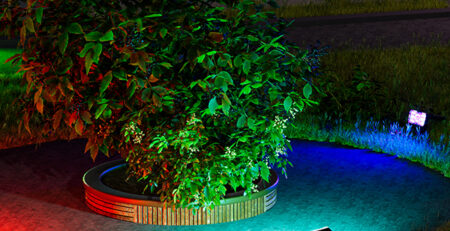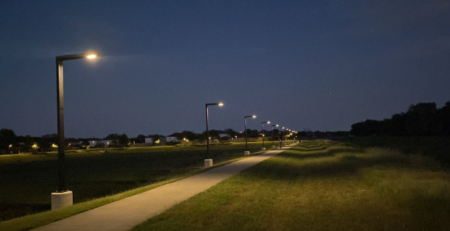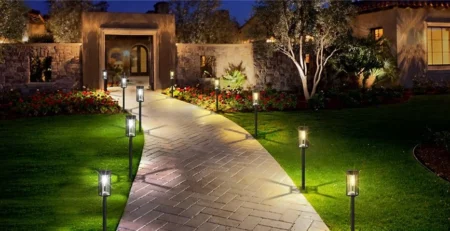How Many Hours Do Solar Lights Work?
Solar lights are becoming increasingly popular as an outdoor lighting solution due to its utility and sustainability. These eco-friendly lights have grown popular among landscape design firms, environmentally concerned construction companies, shops, and even the hospitality industry. However, one issue frequently arises: how long do solar lights last? The response is determined by a number of elements, including the type of solar light, battery capacity, weather conditions, and other variables. BITPOTT (Nantong) is a solar light manufacturer and supplier dedicated to producing high-quality solar products that cater to your needs. If you are interested in wholesale solar lights, please contact us at info@forigat.com or +86-17875369007.
What Factors Affect the Working Hours of Solar Lights?
Several variables influence how long solar lights work after sunset. Understanding these factors can help you select the right solar lighting solutions for your project, whether you are a landscape designer, eco-friendly contractor, or retailer. Let’s dive into the key factors affecting their performance.
Battery Capacity and Type
Rechargeable batteries are essential in solar lights, storing energy collected during the day for nighttime use. The duration a light can run largely depends on the battery’s capacity, measured in milliampere-hours (mAh). Higher-capacity batteries can hold more energy, allowing for longer operation. Among the common types used in solar lights are lithium-ion (Li-ion) and nickel-metal hydride (NiMH) batteries, both known for their excellent storage abilities. However, Li-ion batteries are often preferred in more demanding solar lighting applications because they offer a higher energy density and longer lifespan.
Solar Panel Efficiency
The amount of sunshine that can be transformed into useful energy depends on the solar panel’s efficiency. The associated solar lights will have more stored power to last through the night because high-efficiency panels can produce more electricity in a shorter period of time. In areas where sunlight hours are reduced throughout specific months of the year, this is particularly crucial. Look for solar light panels composed of premium materials, such as monocrystalline silicon, which has higher efficiency than polycrystalline or thin-film panels.
Placement and Sunlight Exposure
Where you place your solar lights will directly affect their performance. Solar lights need to be positioned in areas that receive maximum sunlight exposure during the day. Shaded areas, such as under trees or near buildings, can reduce the amount of sunlight the panel absorbs, leading to shorter working hours at night. For optimal performance, solar lights should be installed in open spaces where they can absorb sunlight throughout the day.
How Long Do Solar Lights Last on a Full Charge?
On a full charge, most solar lights typically work for 6 to 12 hours, depending on the factors mentioned earlier. Let’s break down the working hours in more detail:
Type of Solar Light
Different types of solar lights have varying energy requirements. For instance, solar pathway lights or garden lights generally consume less energy and can last anywhere from 8 to 12 hours on a full charge. On the other hand, solar floodlights or security lights, which require more brightness and power, may last for about 6 to 8 hours, depending on the battery capacity and panel efficiency.
Seasonal Variations
During the summer months, when daylight hours are longer, solar lights can absorb more energy, allowing them to operate longer at night. Conversely, in winter months where sunlight is limited, even a full charge might only last for 4 to 6 hours. This is why selecting high-efficiency panels and large-capacity batteries can be crucial for year-round performance.
Dimming and Motion Sensors
Some solar lights come equipped with features like dimming or motion sensors. These features can help conserve energy by reducing the brightness or turning off the light when it’s not needed, thereby extending the working hours. Lights with motion sensors, for example, will only activate when movement is detected, allowing them to last longer on a full charge compared to lights that stay on continuously.
Do Weather Conditions Impact Solar Light Performance?
Weather conditions can significantly affect the performance and longevity of solar lights. Let’s explore how different weather elements influence solar lighting.
Cloudy Days and Rain
Cloudy weather can reduce the amount of sunlight reaching the solar panel, which in turn reduces the amount of energy the battery can store. On rainy or overcast days, solar lights may only receive a fraction of their usual energy intake, leading to shorter operation times at night. Some high-quality solar panels are better at capturing sunlight even on cloudy days, but in general, you can expect reduced performance during prolonged periods of overcast weather.
Extreme Temperatures
Extreme cold or heat can affect how well solar lights work. Batteries may overheat in hot weather, which shortens their lifespan and decreases their ability to retain a charge. However, freezing temperatures can lower battery efficiency, so reducing the amount of energy that can be stored. Solar lights may not function as well in colder climates throughout the winter, particularly if snow covers the panels and blocks sunlight. Selecting solar lights with temperature-resistant materials and premium batteries that can withstand harsh weather conditions is crucial to reducing these effects.
Wind and Dust
While wind itself doesn’t directly affect solar light performance, strong winds can throw dust and debris onto the solar panel, reducing its ability to absorb sunlight. Over time, accumulated dirt can significantly lower the efficiency of solar panels. To ensure optimal performance, regular cleaning and maintenance of solar panels are necessary, especially in areas prone to dust storms or heavy winds.
How Can You Extend the Battery Life of Solar Lights?
Proper care and maintenance can extend the life of your solar lights’ batteries, ensuring they perform optimally for years to come. Here are some effective ways to extend battery life:
Regular Cleaning and Maintenance
Keeping the solar panel clean is crucial for maximizing energy absorption. Dust, dirt, or bird droppings can block sunlight, reducing the amount of energy the panel can convert. Regularly wiping down the panel with a damp cloth can help maintain its efficiency. For installations in particularly dusty or debris-prone areas, consider cleaning the panels weekly or bi-weekly.
Battery Replacement
Even with proper care, solar light batteries will eventually degrade over time. Most rechargeable batteries in solar lights last between 1 to 3 years, depending on usage and exposure to elements. To keep your solar lights performing efficiently, it’s a good practice to replace the batteries every few years. Opting for high-quality replacement batteries, such as lithium-ion or NiMH, can enhance the performance and longevity of your solar lighting system.
Use of Energy-Saving Features
Many modern solar lights come equipped with features like automatic dimming, motion sensors, or timers that help conserve battery life. Utilizing these features can significantly extend the working hours of your solar lights. For example, a solar light with a motion sensor will only turn on when movement is detected, saving energy during periods of inactivity.
Additionally, some solar lights have adjustable brightness settings that allow users to decrease the intensity of the light. Lower brightness settings consume less energy, which can help the light function for longer hours, especially during periods of reduced sunlight.
Conclusion
The operational duration of solar lights is influenced by several elements, such as the specific type of light, the capacity of the battery, the efficiency of the solar panel, and prevailing weather conditions. Typically, when fully charged, most solar lights can function for a period ranging from 6 to 12 hours, offering dependable and environmentally friendly lighting for areas like gardens, walkways, campsites, and beyond. By comprehending these variables and adequately maintaining your solar lights, you can guarantee optimal performance over an extended period.
Where to Buy Solar Lights?
If you’re looking to invest in high-quality solar lights for your next project, BITPOTT (Nantong) New Energy Technology Co., Ltd. is a trusted solar light manufacturer specializing in innovative solar products. Whether you’re a retailer seeking wholesale solar lights or a business in need of sustainable lighting solutions, BITPOTT offers a wide range of durable, efficient, and eco-friendly products to meet your needs. With our expertise in traditional solar products, power storage technologies, and quality assurance, we ensure that our solar lights exceed industry standards.
For more information or to purchase wholesale solar lights, feel free to contact us at info@forigat.com or call +86-17875369007.
References
1. Solar Power for Outdoor Lighting. Published by Renewable Energy World.
2. Battery Efficiency in Solar Systems. Published by the Solar Energy Research Institute.
3. Solar Panel Efficiency: Monocrystalline vs. Polycrystalline. Published by the Clean Energy Council.
4. Impact of Weather on Solar Energy Production. Published by the National Renewable Energy Laboratory.
5. Tips for Maintaining Solar Lights in Harsh Weather. Published by Solar Power Today.
6. Maximizing Solar Light Performance. Published by Energy Efficiency Magazine.











Leave a Reply